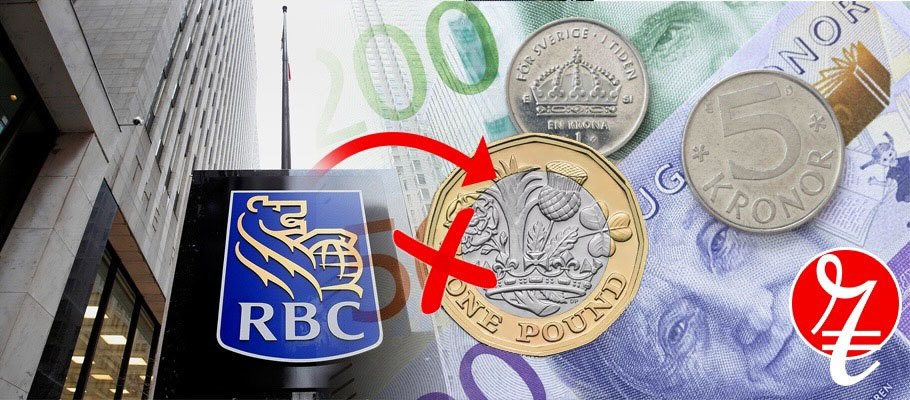
Published: June 29th, 2022
Forex analysts at RBC Capital markets believe GBP will be hit by losses against SEK in the coming days. The bank is confident enough in its analysis to make a sell recommendation for GBP/SEK covering the remainder of this week’s trading session.
A market analysis from the bank’s FX Strategy unit follows another Nordic-themed recommendation made last week (wc 20 June) to buy Norwegian Krone against its Swedish counterpart, a trade that RBC Capital says netted a 0.4 per cent profit.
Seasonal factors look to be the major driver behind the recommendation, as a month-end trend ‘now favours GBP/SEK lower from both sides.’
‘For Sterling, flows are being heavily influenced by UK institutions reducing their USD short positions. This is due to a fall in US equity prices that’s left them over-hedged on their positions.’
On the SEK side, the bank says flow is being driven by offshore investors holding Swedish equities. ‘They will have SEK to buy, given the close-to-six per cent fall in the OMX. In July, the Pound will likely have to absorb another run of negative news due to the EU’s response to the Westminster’s legislation to override the Northern Ireland trade protocol.’
Against that backdrop, SEK will also feel the impact of the Swedish Riksbank’s pending decision on interest rates, which markets believe will deliver a 50-basis point hike.
RBC Capital analysts see the outcome for SEK from a rate hike as ‘neutral’. They’re targeting a move lower for the GBP/SEK exchange rate to 12.13.
Spot is currently located at 12.38 as a 0.25 per cent drop places the trade on a strong footing for gains at time of writing.
Since mid-April, GBP/SEK has sustained a tight range. The pair’s rangebound nature might indicate limited scope for a significant breakout in either direction, RBC says.
In late May, global investment giant JP Morgan said Britain was turning into a cautionary tale about the problems stagflation can bring, prompting the Wall Street stalwart to slash its GBP forecasts.
In its monthly currency briefing, Morgan analysts said they were revising their Pound forecasts downward, adding that USD’s appreciation trend hand yet to run its course, while EUR was also likely to come under pressure.
The Pound, they said, was stuck in a ‘stagflationary spiral’ driven by spiking inflation in the short-term while economic growth was drifting back to near-recession levels.
‘It would be understating things to call this combination of zero growth and double-digit inflation toxic for the Pound’s exchange rate. We are pulling back our Pound forecasts again as a result.’
It’s worth noting that Morgan’s bearish comment came ahead of a rebound in Sterling’s value against the Dollar, when the Pound to Dollar exchange pushed up to 1.2572 from lows of 1.2154 in mid-May.
Some analysts said at the time that a break below 1.20 was very possible. The Pound to Euro rate also rose from mid-month lows to touch 1.1779 at time of writing.
The GBP losses seen in the first half of May were prompted by negative market reaction to the Bank of England's May fifth policy update, when bank economists expressed a downbeat forecast for Britain’s economy over coming months and years.
Any rally by GBP and EUR against USD would represent a relief-style bounce and a countertrend in the context of Morgan's revised forecasts. Morgan analysts said the revised cut to their Sterling forecast also reflected the rising expectation that UK trade relations with the EU will be hit by retaliatory measures over the trade legislation currently winding its way through parliament, which will effectively nullify the Northern Ireland Protocol.
The protocol allows for free movement of goods between the UK and Northern Ireland without necessitating a ‘hard’ border with the Irish republic. All that is set to change if the legislation passes, triggering what some fear will be a resumption of sectarian violence.
Morgan said that that Brussels will almost certainly retaliate with punitive tariffs, fines, or court action that could aggravate the ‘already concerning deterioration in Britain’s balance of trade.’
Morgan reduced its one-year GBP/USD target from 1.30 to 1.17, with a trough forecast for the third quarter when analysts believe the pair will dip to 1.13.
The investment bank’s EUR/GBP forecasts were raised in response to cyclical outlook that’s ‘moved into the negative’, they said, dropping from 0.87 from 0.83. The pair’s forecast for the third quarter was reset to 0.87. 'Britain’s status as stagflation’s European posterchild is fundamental to our revised upward target for EUR/GBP.’
Sterling started the month under notable pressure when the Bank of England raised interest rates while warning that economic growth could hit the brakes over coming months alongside. That was paired with a second warning that UK inflation could reach 10 per cent later in 2H 2022.
Threadneedle Street raised interest rates by 25 basis points to 1 per cent the very same day after its Monetary Policy Committee (MPC) voted 6-3 to raise the Bank Rate. The three dissenting votes were actually looking for a bigger 50 basis point hike.
Minutes of the policy meeting showed that some MPC members favoured more aggressive action to cool boiling inflation.
Analysts say that made the vote share 'hawkish' on balance and would have supported the Pound, had the economic forecasts included in the Monetary Policy Report been more 'dovish'.
The Bank’s assumptions and economic forecasts expressed a solidly negative view about Britain’s economic outlook. Forex traders started offloading their Sterling positions almost immediately, sending GBP down early in June against its major economy peers.
The Pound to Euro exchange rate dropped one per cent to 1.1748 in the aftermath of the BoE’s update, while the Pound to Dollar exchange rate fell 1.76 per cent to trade at 1.2360.